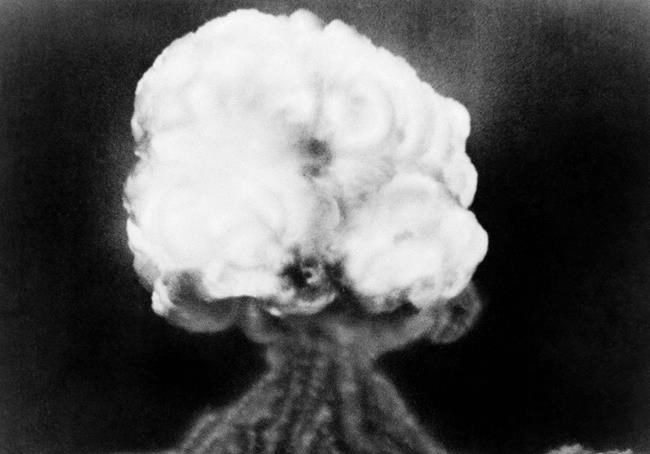
FILE - This July 16, 1945, file photo, shows the mushroom cloud of the first atomic explosion at Trinity Test Site near Alamagordo, N.M. Residents of the New Mexico Hispanic village near the site of the world's first atomic bomb test are planning another protest outside the annual opening of the site to visitors. The Tularosa Basin Downwinders Consortium say they will picket outside the gates of the White Sands Missile Range April 6, 2019, as tourists travel to see the location of the Trinity Test. (AP Photo/File)
Republished April 01, 2019 - 11:12 AM
Original Publication Date March 31, 2019 - 9:01 PM
ALBUQUERQUE, N.M. - Residents of a New Mexico Hispanic village near the site of the world's first atomic bomb test are planning another protest outside the annual opening of the site to visitors.
The Tularosa Basin Downwinders Consortium announced last week it will picket outside the gates of the White Sands Missile Range as the base opens up April 6 for tourists to see the location.
"We'll be there and we expect a big crowd as more people find out about our stories," said Tina Cordova, a co-founder of the group and cancer survivor. "We want to put faces to names and will talk to another who will listen.
The picket comes as a proposal to include New Mexico residents in the federal Radiation Exposure Compensation Act remains stalled in Congress.
Democratic U.S. Sens. Tom Udall and Martin Heinrich of New Mexico announced Monday they have reintroduced changes to the Radiation Exposure Compensation Act to include residents near the Trinity Test.
"Justice is long, long overdue for the New Mexico families and tribal members who are victims of radiation exposure as a result of the government's nuclear testing during the Cold War," Udall said in a statement.
Advocates want the federal Radiation Exposure Compensation Act amended so people lived near the site can be included. The law only covers areas in Nevada, Arizona and Utah that are downwind from a different nuclear test site.
Under that law, people who lived near nuclear testing sites receive compensation for health problems.
Consortium members say many who lived near site weren't told it involved an atomic weapon until the U.S. dropped bombs on the Japanese cities of Hiroshima and Nagasaki and World War II ended. They said scientists seldom came to check on them to examine the effects.
Scientists working in Los Alamos developed the atomic bomb as part of the Manhattan Project, which provided enriched uranium for the weapon. The secret program also involved facilities in Oak Ridge, Tennessee, and Hanford, Washington.
The bomb was tested in a stretch of the New Mexico desert near towns with Hispanic and Native American populations. Military officials at the time called the test the "Trinity Test."
According to White Sands Missile Range, the open house is free.
White Sands Missile Range did not immediately return an email to its general public affairs office email address.
Visitors can take a quarter-mile walk to ground zero where a small obelisk marks the exact spot where the bomb was detonated. Historical photos are mounted on the fence surrounding the area.
Members of the Tularosa Basin Downwinders Consortium are raising money to testify before Congress later this year.
___
Russell Contreras is a member of The Associated Press' race and ethnicity team. Follow him on Twitter at http://twitter.com/russcontreras
News from © The Associated Press, 2019